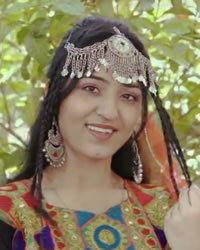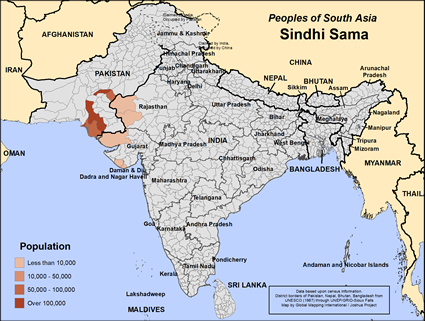Sindhi Sama in Pakistan

Photo Source:
FD productions - Wikimedia
Creative Commons
|

Map Source:
People Group Location: Omid. Other geography / data: GMI. Map Design: Joshua Project
|
| People Name: | Sindhi Sama |
| Country: | Pakistan |
| 10/40 Window: | Yes |
| Population: | 1,630,000 |
| World Population: | 1,630,000 |
| Primary Language: | Sindhi |
| Primary Religion: | Islam |
| Christian Adherents: | 0.00 % |
| Evangelicals: | 0.00 % |
| Scripture: | Complete Bible |
| Ministry Resources: | Yes |
| Jesus Film: | Yes |
| Audio Recordings: | Yes |
| People Cluster: | South Asia Muslim - other |
| Affinity Bloc: | South Asian Peoples |
| Progress Level: |
|
Introduction / History
The word Sindhi comes from the Persian word meaning those who inhabit the Indus Valley. All Sindhi were originally Hindu or Buddhist. In the early 8th century, many of these people converted to Islam with the coming of the Muslim armies. The Sama Sindhi claim to be descendants of the rulers of the Samma Dynasty. This royal family reigned over the Indus Valley and west India from the 14th to early 16th century.
Most Muslim Sindhi from India moved to Pakistan during the Partition of 1947. Equal numbers of Hindu and Sikh Sindhi immigrated to India.
The primary language of the Sama Sindhi in Pakistan is Sindhi. They also speak Urdu and other regional Pakistani languages.
The Sama Sindhi live in the Indus Valley in the southeast region of Pakistan.
What Are Their Lives Like?
The lives of the Sama Sindhi are diverse depending upon whether they live in urban or rural areas. The rural Sama live lives much like their ancestors. Today, most of the Sama Sindhi are engaged in irrigation farming. Their principal crops include wheat, rice, cotton, sugarcane, various fruits and oilseed. Some farmers also raise sheep, goats and camels. The Sindhi living in cities often work as merchants, physicians, lawyers and teachers.
The family is the basic unity of Sama Sindhi society, with the male head being the authority. Unlike other Muslims, the Sindhi tend to organize in caste groups based on clan and occupation. The Sindhi do not marry outside of their own caste. Marriages between cousins are common. The wedding ceremony includes a reading from the Koran and is performed by a local Muslim teacher or priest.
What Are Their Beliefs?
Most of the Sama Sindhi are Sunni Muslims of the Hanafi School. The majority of the rural Sindhi, however, have no clear understanding of their Muslim faith and still believe in folk spirits. Before 1947, many Hindu and Muslim practices were combined. For example, both Hindus and Muslims often venerated the same saint. Today, the practice of saint worship still persists among the rural Sama Sindhi people.
Islam is a major world religion that is based on five essential duties or "pillars": (1) A Muslim must affirm that "there is no god but Allah and Mohammed is his prophet." (2) Five times a day he must pray while facing Mecca. (3) He must give an obligatory percentage (very similar to tithes) on an annual basis. (4) He must fast during Ramadan, the ninth month of the Muslim year. (5) He must try to make at least one pilgrimage to Mecca in his lifetime. Muslims are also prohibited to drink alcohol, eat pork, gamble, steal, use deceit, slander and make idols.
The two main holidays for Sunni Muslims are Eid al Fitr, the breaking of the monthly fast and Eid al Adha, the celebration of Abraham's willingness to sacrifice his son to Allah.
What Are Their Needs?
The Sama Sindhi need to hear the life-changing message of Jesus Christ in a way they can understand. Sindhi who live in a rural setting need help in educating their children and in learning new job skills.
Prayer Points
Ask God to send missionary teams who will go to the Sama Sindhi and share the gospel with them.
Pray for effectiveness of the JESUS Film among the Sama Sindhi, with many giving their hearts and lives to Jesus Christ.
Pray that strong local churches will be raised up among the Sama Sindhi people for the glory of Christ.